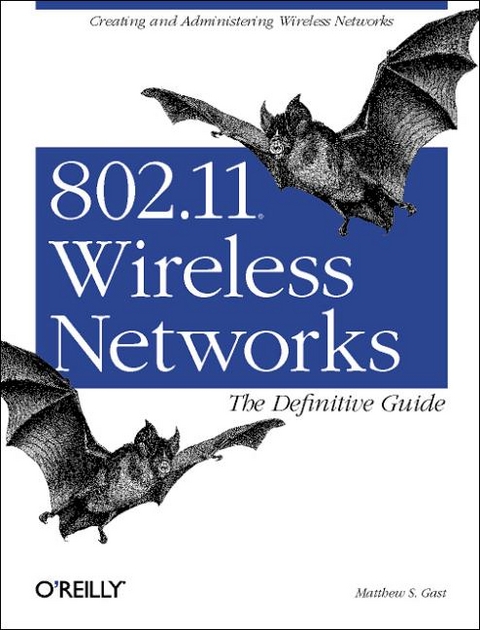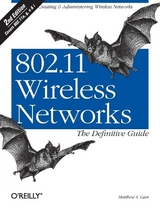
802.11 Wireless Networks
O'Reilly Media (Verlag)
978-0-596-00183-4 (ISBN)
- Titel erscheint in neuer Auflage
- Artikel merken
As a network administrator, architect, or security professional, you need to understand the capabilities, limitations, and risks associated with integrating wireless LAN technology into your current infrastructure. 802.11 Wireless Networks: The Definitive Guide provides all the information necessary to analyze and deploy wireless networks with confidence. Over the past five years, the world has become increasingly mobile. Traditional ways of networking have altered to accommodate new lifestyles and ways of working. Wireless networks offer several advantages over fixed (or wired) networks, with mobility, flexibility, ease and speed of deployment, and low-cost at the top of the list. Large productivity gains are possible when developers, students, and professionals are able to access data on the move. Ad-hoc meetings in the lunch room, library, or across the street in the cafe allow you to develop ideas collaboratively and act on them right away. Wireless networks are typically very flexible, which can translate into rapid deployment. Once the infrastructure is in place, adding new users is just a matter of authorization.
After a general introduction to wireless networks, this practical book moves quickly into the gory details of the 802.11 standard. If you ever need to debug a wireless network that isn't working properly, you'd better understand this material. 802.11 MAC (Media Access Control), detailed 802.11 framing, WEP (Wired Equivalent Privacy protocol), 802.1x, management operations, and the PCF (point coordination function) are all covered in detail. Author Matthew Gast also supplies impressive detail on the physical layers. As for getting a wireless network up and running...Gast offers clear, no-nonsense guide for using 802.11 on Windows and Linux, using and selecting access points, making deployment considerations, and seeing to 802.11 network monitoring and performance tuning. In the final section of the book, he summarizes the standardization work pending in the 802.11 working group. If you're looking for one book that provides a full spectrum view of 802.11, from the minute details of the specification, to deployment, monitoring, and troubleshooting, 802.11 Wireless Networks: The Definitive Guide is worth its weight in gold.
Matthew Gast was born on the Great Plains of the Midwest, near Chicago. Living on the Great Plains, he could almost see all the way to Iowa, where he later attended Grinnell College. In college, he started two significant long-term relationships. The first is with the fiercely independent Alison Burek, a musician, painter, and Renaissance woman. To the great joy of their two cats, they were married shortly after graduation. The second "relationship" is with Unix, initially one of Matthew's prime methods of procrastination and later the gateway to network literacy. He uses his home network to experiment with new technologies, and scares away intruders by discussing its architecture. Currently, Matthew is interested in routing, security, cryptography, and mobile communications. He now works at Nokia as a travelling technical wizard and is the resident frequent travel reward program expert. In respites between business trips, Matthew lives in the San Francisco Bay Area with Ali, who is trying to make sure he doesn't grow up before his time, an event she hopes to postpone indefinitely.
Preface 1. Introduction to Wireless Networks Why Wireless? A Network by Any Other Name... 2. Overview of 802.11 Networks IEEE 802 Network Technology Family Tree 802.11 Nomenclature and Design 802.11 Network Operations Mobility Support 3. The 802.11 MAC Challenges for the MAC MAC Access Modes and Timing Contention-Based Access Using the DCF Fragmentation and Reassembly Frame Format Encapsulation of Higher-Layer Protocols Within 802.11 Contention-Based Data Service 4. 802.11 Framing in Detail Data Frames Control Frames Management Frames Frame Transmission and Association and Authentication States 5. Wired Equivalent Privacy (WEP) Cryptographic Background to WEP WEP Cryptographic Operations Problems with WEP Conclusions and Recommendations 6. Security, Take 2: 802.1x The Extensible Authentication Protocol 802.1x: Network Port Authentication 802.1x on Wireless LANs 7. Management Operations Management Architecture Scanning Authentication Association Power Conservation Timer Synchronization 8. Contention-Free Service with the PCF Contention-Free Access Using the PCF Detailed PCF Framing Power Management and the PCF 9. Physical Layer Overview Physical-Layer Architecture The Radio Link RF and 802.11 10. The ISM PHYs: FH, DS, and HR/DS 802.11 FH PHY 802.11 DS PHY 802.11b: HR/DSSS PHY 11. 802.11a: 5-GHz OFDM PHY Orthogonal Frequency Division Multiplexing (OFDM) OFDM as Applied by 802.11a OFDM PLCP OFDM PMD Characteristics of the OFDM PHY 12. Using 802.11 on Windows Nokia C110/C111 Lucent ORiNOCO 13. Using 802.11 on Linux A Few Words on 802.11 Hardware PCMCIA Support on Linux Linux-wlan-ng for Intersil-Based Cards Agere (Lucent) Orinoco 14. Using 802.11 Access Points General Functions of an Access Point ORiNOCO (Lucent) AP-1000 Access Point Nokia A032 Access Point 15. 802.11 Network Deployment The Topology Archetype Project Planning The Site Survey Installation and the Final Rollout 16. 802.11 Network Analysis Why Use a Network Analyzer? 802.11 Network Analyzers Commercial Network Analyzers Ethereal 802.11 Network Analysis Examples AirSnort 17. 802.11 Performance Tuning Tuning Radio Management Tuning Power Management Timing Operations Physical Operations Summary of Tunable Parameters 18. The Future, at Least for 802.11 Current Standards Work The Longer Term The End A. 802.11 MIB B. 802.11 on the Macintosh Glossary Index
| Erscheint lt. Verlag | 28.5.2002 |
|---|---|
| Zusatzinfo | glossary, index |
| Verlagsort | Sebastopol |
| Sprache | englisch |
| Maße | 178 x 233 mm |
| Gewicht | 730 g |
| Einbandart | kartoniert |
| Themenwelt | Mathematik / Informatik ► Informatik ► Netzwerke |
| ISBN-10 | 0-596-00183-5 / 0596001835 |
| ISBN-13 | 978-0-596-00183-4 / 9780596001834 |
| Zustand | Neuware |
| Haben Sie eine Frage zum Produkt? |
aus dem Bereich



